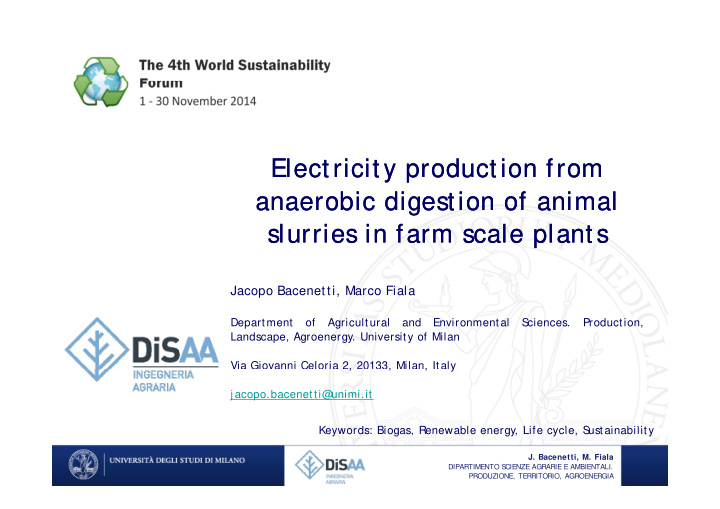



Electricity production from Electricity production from anaerobic digestion of animal anaerobic digestion of animal anaerobic digestion of animal anaerobic digestion of animal slurries in farm scale plants slurries in farm scale plants Jacopo Bacenetti, Marco Fiala Department of Agricultural and Environmental S ciences. Production, Landscape, Agroenergy. University of Milan Via Giovanni Celoria 2, 20133, Milan, Italy , , , y j acopo.bacenetti@ unimi.it Ke Keywords: Biogas, Renewable energy, Life cycle, S ords: Biogas Rene able energ Life c cle S stainabilit ustainability J. Bacenetti, M. Fiala DIPARTIMENTO S CIENZE AGRARIE E AMBIENTALI. PRODUZIONE, TERRITORIO, AGROENERGIA
INTRODUCTION & AIM Life Cycle Assessment (LCA) is a methodology to assess the potential environmental impacts and resources’ consumption associated with a production system (IS O 14040, 2006): 4 steps BIOGAS BIOGAS BIOGAS BIOGAS & ENVITONMENT & ENVITONMENT & ENVITONMENT & ENVITONMENT GOAL AND SCOPE DEFINITION N TERPRETATIO TERPRETATIO LIFE CYCLE LIFE CYCLE INT INT INVENTOrY INVENTOrY INVENTOrY INVENTOrY IMP IMP ACT ACT ULTS ULTS BENEFIT BENEFIT RES RES IMP IMP IMP IMP ACT ACT ACT ACT AS AS S S ES ES S S MENT MENT E.g. Crop E.g. fertilizer cultivation, substitution, heat emissions from and electricity biogas combustion, g , g generation from renewable sources lossess of methane, AIM AIM: : to assess the environmental profile of electricity production from four different AD plants mainly fed with animal slurry and electrical power lower than 300 kW i h i l l d l i l l h 300 kW J. Bacenetti, M. Fiala DiSAA www.disaa.unimi.it
LCA of BIOGAS PLANTS Four biogas plant (LCA) located in Northern Italy and are fed mainly with animal slurry). Biogas plant A B C D District District Unit Unit Cremona Cremona Lodi Lodi Pavia Pavia Cremona Cremona Electrical power kW 100 250 300 300 Starting year - 2013 2010 2013 2013 Cow slurry Pig slurry Cow slurry Cow slurry Pig slurry Pig slurry 35 t/ day 35 t/ day 45 t/ day 45 t/ day Feeding rate t/ day 40 t/ day 180 t/ day Maize silage Maize silage 13 t/ day 14 t/ day Electric self % 7.0 7.6 9.2 8.4 consumption consumption 1.5 for Cow 1.3 for Pig Transport slurry slurry km 0.1 3.5 Distance 0.8 for 0.7 for Maize Maize silage Maize silage silage silage Partially Surplus heat - Wasted Wasted Wasted valorized FUNCTIONAL UNIT : 1 kWh of electricity ILCD method Evaluated impact categories: climate change (CC), ozone depletion (OD), particulate matter (PM); photochemical oxidant formation (POF); acidification (TA), freshwater eutrophication (FE), terrestrial eutrophication (TE) marine eutrophication (ME), and mineral, fossil and renewable resource Depletion (MFRD) J. Bacenetti, M. Fiala DiSAA www.disaa.unimi.it
100 RES ULTS For 5 impact categories 80 80 (CC (CC, OD, PM, POF and OD PM POF and ME), the Italian Italian electricity electricity has has an an higher higher environmental environmental 60 impact impact impact impact than than electric electric energy from AD plants. e results 40 For AC, TE, FE it has a %) (% lower lower lower lower impact impact impact impact than than EE EE Relativ from the AD plants (C 20 and D) fed with maize . Plant A produces EE with Plant A produces EE with 0 the lowest impact: Climate Ozone Particulate Photochemical Acidification Terrestrial Freshwater Marine Mineral, fossil change depletion matter ozone eutrophication eutrophication eutrophication & ren resource thanks to the heat- formation depletion valorization credits, for ‐ 20 3 3 OD OD, FE FE and and MFRD MFRD Plant A ‐ Cow slurry Plant B ‐ Pig slurry Plant C ‐ Cow slurry & Maize Silage environmental environmental benefits benefits Plant D ‐ Pig slurry & Maize Silage Electricity, ITA are achieved. ‐ 40 Plants (C and D) fed also with maize silage maize silage show a considerably higher impact higher impact for AC, TE, FE and ME: the fertilizer applications during maize cultivation involve emissions of ammonia in the air as well as nitrogen leaching and phosphate losses J. Bacenetti, M. Fiala DiSAA www.disaa.unimi.it
CONCLUS IONS The electricity produced from the AD plants fed with animal slurry has better environmental environmental performances performances than electricity produced from fossil fuels, whereas for AD plants fed with maize silage this is true only for those impact categories not related to ammonia and dinitrogen monoxide emissions and to nitrate and phosphate leaching nitrate and phosphate leaching. Recovery and valorization of surplus surplus heat heat (Plant A) significantly reduce the environmental burdens. The use of energy crops ( maize silage maize silage ) considerably increase the environmental impact of electricity from bi biogas CAREFULLY ASSESS THE ENVIRONMENTAL SUSTAINABILITY FOR ELECTRICITY PRODUCED BY BIOGAS CAREFULLY ASSESS THE ENVIRONMENTAL SUSTAINABILITY FOR ELECTRICITY PRODUCED BY BIOGAS PLANT FED WITH ENERGY CROPS PLANT FED WITH ENERGY CROPS LCA Group LCA Group AGRO-ENERGY and FOOD PROCES AGRO G O G O ENERGY and FOOD PROCES N N G a d OO G a d OO OC S OC S S SNG S SNG ING ING PhD: marco.fiala@ unimi.it - +39 503 16868 Prof. Marco Fiala, PhD Prof. Marco Fiala, PhD: j acopo.bacenetti@ unimi.it - +39 503 16869 Dr. Jacopo Dr. Jacopo Bacenetti Bacenetti, , PhD J. Bacenetti, M. Fiala DiSAA www.disaa.unimi.it
Recommend
More recommend